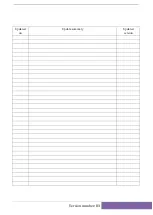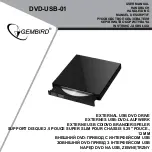
F-26 Motor Noise (Carrier Freq)
Select the carrier frequency. Changing the switching frequency
can help to reduce acoustic noise from the motor. Default
depends on power size.
Option:
Function:
[9]
7.0 kHz
[10]
8.0 kHz
[11]
10.0 kHz
[12]
12.0kHz
[13]
14.0 kHz
[14]
16.0kHz
F-27 Motor Tone Random
Option:
Function:
[0]
*
Off
No change of the acoustic motor switching noise.
[1]
On
Transforms the acoustic motor switching noise from a
clear ringing tone to a less noticeable ‘white’ noise.
This is achieved by slightly and randomly altering the
synchronism of the pulse width modulated output
phases.
F-28 Dead Time Compensation
Option:
Function:
[0]
Off
No compensation.
[1]
*
On
Activates dead time compensation.
F-29 Start Current
Range:
Function:
0 A
*
[0 - par.
P-03 A]
Some motors, e.g. cone rotor motors, need extra
current/starting speed to disengage the rotor. To
obtain this boost, set the required current in
. Set
. Set
[3] Start speed cw
or
[4]
Horizontal operation
, and set a start delay time
in
This parameter can be used for hoist
applications (cone rotor).
3.3.5 F-3# Fundamental 3
Parameters to configure drive Advanced Switching Pattern
and Overmodulation.
F-37 Adv. Switching Pattern
Option:
Function:
Select the switching pattern: 60° AVM or SFAVM.
[0]
*
60 AVM
[1]
SFAVM
F-38 Overmodulation
Option:
Function:
[0]
Off
Select
[0] Off
for no overmodulation of the output
voltage, in order to avoid torque ripple on the
F-38 Overmodulation
Option:
Function:
motor shaft. This feature may be useful for
applications such as grinding machines.
[1]
*
On
Select
[1] On
to enable the overmodulation
function for the output voltage. This is the right
choice when it is required that the output voltage
is higher than 95% of the input voltage (typical
when running over-synchronously). The output
voltage is increased according to the degree of
overmodulation.
NOTE
Overmodulation leads to increased torque
ripple as harmonics are increased.
Control in FLUX mode provides an output current
of up to 98% of the input current, regardless of
[2]
Optimal
3.3.6 F-4# Fundamental 4
Parameters to configure drive torque and current limits.
F-40 Torque Limiter (Driving)
Range:
Function:
160.0 %
*
Application
dependent
*
[0 - 1000.0 %]
[Application
dependant]
This function limits the
torque on the shaft to
protect the mechanical
installation.
NOTE
Changing
when
is set to
[0] Speed open loop
,
is automatically readjusted.
NOTE
The torque limit reacts on the actual, non-filtrated torque,
including torque spikes. This is not the torque that is seen
from the keypad or the Fieldbus as that is filtered.
F-41 Torque Limiter (Braking)
Range:
Function:
100 %
*
[0 - 1000.0 %] This function limits the torque on the
shaft to protect the mechanical instal-
lation.
NOTE
The torque limit reacts on the actual, non-filtrated torque,
including torque spikes. This is not the torque that is seen
from the keypad or the Fieldbus as that is filtered.
Parameter Descriptions
AF-650 GP Programming Guide
38
DET-618C
3
3
















































